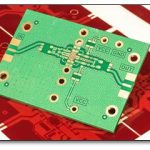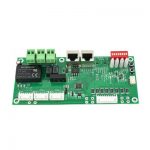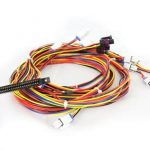What are PCB Vias?
PCB vias are small holes drilled through a printed circuit board that allow electrical signals to pass from one layer of the board to another. Vias are an essential component in multi-layer PCBs, enabling more complex and compact designs by allowing traces to cross over each other without making electrical contact.
Vias come in several different types, each with their own characteristics and uses. Choosing the right type of via is crucial for ensuring the reliability, manufacturability, and cost-effectiveness of a PCB design.
Types of PCB Vias
There are four main types of PCB vias:
- Through-hole vias
- Blind Vias
- Buried vias
- Micro vias
Let’s look at each type in more detail.
Through-Hole Vias
Through-hole vias are the most basic and common type of via. They go all the way through the PCB, from the top layer to the bottom layer. Through-hole vias are typically larger in diameter than other types of vias, with sizes ranging from 0.3mm to 0.8mm.
| Advantages | Disadvantages |
|---|---|
| Easy to manufacture | Consumes more board space |
| Provides strong mechanical connection | Limits component placement on both sides |
| Suitable for high-power applications | Higher cost compared to other via types |
Through-hole vias are often used in simpler, double-sided PCB designs or in areas of a board that require a sturdy mechanical connection, such as connectors or large components.
Blind Vias
Blind vias are a type of via that starts on an outer layer and terminates on an inner layer, without going all the way through the board. Blind vias allow for more compact designs by freeing up space on the opposite side of the board.
| Advantages | Disadvantages |
|---|---|
| Allows for higher component density | More complex to manufacture |
| Improves signal integrity | Higher cost compared to through-hole vias |
| Suitable for high-speed applications | Limited to connecting Outer Layers to inner layers |
Blind vias are commonly used in high-density PCB designs, such as smartphones, tablets, and wearable devices, where space is at a premium.
Buried Vias
Buried vias are similar to blind vias, but instead of starting on an outer layer, they connect two or more inner layers without being visible on either the top or bottom of the PCB. Buried vias offer even greater design flexibility and space savings compared to blind vias.
| Advantages | Disadvantages |
|---|---|
| Allows for the most compact designs | Most complex to manufacture |
| Improves signal integrity | Highest cost compared to other via types |
| Suitable for the highest-speed applications | Limited to connecting inner layers |
Buried vias are used in the most advanced and complex PCB designs, such as those found in high-performance networking equipment, aerospace systems, and medical devices.
Micro Vias
Micro vias are the smallest type of via, with diameters typically ranging from 0.05mm to 0.15mm. They can be either blind or buried, and are used to create high-density interconnects between layers.
| Advantages | Disadvantages |
|---|---|
| Enables the highest component density | Requires specialized manufacturing equipment |
| Ideal for fine-pitch components | Higher cost compared to larger vias |
| Suitable for high-speed, high-frequency applications | More susceptible to manufacturing defects |
Micro vias are essential in cutting-edge PCB designs, such as those found in advanced packaging technologies like system-in-package (SiP) and package-on-package (PoP). They are also used extensively in high-bandwidth applications, like 5G wireless networks and high-speed data centers.
Choosing the Right Via Type
Selecting the appropriate via type for a PCB design depends on several factors, including:
- The complexity and density of the design
- The required signal integrity and speed
- The available board space
- The manufacturing capabilities and cost constraints
In general, through-hole vias are the most cost-effective and easiest to manufacture, making them a good choice for simpler designs or prototypes. As designs become more complex and space-constrained, blind and buried vias offer greater flexibility and performance, albeit at a higher cost.
Micro vias are reserved for the most demanding applications, where the highest density and signal integrity are required. However, they also come with the highest manufacturing costs and the greatest risk of defects.
Ultimately, the choice of via type should be made in close consultation with the PCB Manufacturer to ensure that the design is optimized for manufacturability, reliability, and cost-effectiveness.

FAQ
1. What is the difference between a via and a through-hole?
A via is a small hole drilled in a PCB to connect different layers, while a through-hole is a larger hole used to mount components. Vias are used exclusively for electrical connections, whereas through-holes serve both electrical and mechanical purposes.
2. Can blind vias be used to connect inner layers?
No, blind vias can only connect an outer layer to one or more inner layers. To connect inner layers without being visible on the surface, buried vias must be used.
3. What is the smallest size of via that can be manufactured?
The smallest vias currently available are micro vias, with diameters as small as 0.05mm (50 microns). However, the minimum via size that can be reliably manufactured depends on the capabilities of the PCB fabricator and the specific requirements of the design.
4. Are vias necessary in single-layer PCBs?
No, vias are not necessary for single-layer PCBs since there are no other layers to connect. Single-layer designs use only through-holes for mounting components.
5. How do vias affect the signal integrity of a PCB?
Vias can have a significant impact on signal integrity, especially in high-speed designs. Vias can introduce discontinuities, reflections, and crosstalk, which can degrade signal quality. To minimize these effects, designers must carefully consider the placement, size, and type of vias used, as well as implementing appropriate signal conditioning techniques, such as impedance matching and ground stitching.






Leave a Reply